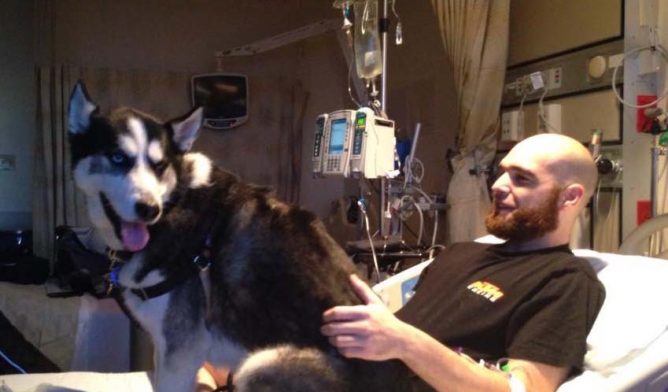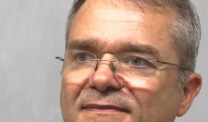Hospice Ending Lifted Young Mesothelioma Patient
Cancer & CaregivingWritten by Tim Povtak | Edited By Walter Pacheco

Less than 36 hours before he died, pleural mesothelioma patient Randy Sloan was sailing across his beloved San Francisco Bay — breeze in his face, sun at his back, and family and friends all around.
He was laughing.
“Randy lived a lot while he was dying,” said his mother, Melany Baldwin. “Right ’til the end, he was always, ‘OK. We got another day. What do you want to do?'”
Sloan died on his terms, much like he lived, and he made the best of a bad situation: Teaching others that life shouldn’t end until the last breath is taken.
He opted for quality of life, bypassing debilitating surgery, and more toxic chemotherapy that may have given him a few extra days.
“He was himself until the end,” Baldwin told Asbestos.com. “And that was how he wanted it. He had the best possible medical care, and the best possible dying care. At the end, he opted for a shorter, better life.”
Zen Hospice Became a Blessing
Sloan was just 27 when he died, shockingly young for someone with this rare and aggressive cancer that typically strikes those during retirement and after a long-before occupational exposure to asbestos.
He spent his final eight days living like he wished at the Zen Hospice Project, a small pioneering facility in San Francisco that may change the way people with a terminal illness die.
Most palliative care and hospice facilities are built around a premise that patients’ wishes should be honored in their final days, but the independent, nonprofit Zen Hospice Project took an extra step to truly make it happen for Sloan.
“I just hope that more people will have access to something like this,” Baldwin said. “If you’ve got to go — and he did — why not go out the best way possible?”
Living His Life
Sloan went sailing that day, docking at Angel Island in San Francisco Bay for a burgers-and-brats cookout like he and his motorcycle buddies always did on Sundays when the weather was good. He needed assistance, and there was plenty around him.
He and his father went out alone to a nearby diner later that night to tell “remember when…” stories, share memories and enjoy one last plate of fried eggs and hash browns.
Earlier that week, he ate the deep-fried peanut butter and jelly sandwich smothered in mayonnaise that he loved so much.
He and his mom drove to the top of nearby Twin Peaks, where he admitted his presidency of the clandestine Nighttime Scooter Club, which once held 75 mph downhill races in the dark.
He drank beer with his buddies. He smoked a cigarette on the nearby park bench. He invited Desmo, his dog, into bed with him.
Sloan hosted a steady stream of friends in his room, where they played loud music and video games, staying up way too late.
He broke all the rules of dying. And he enjoyed it, despite the physical pain he was enduring.
“For him, it was the best possible ending, after being dealt a really crappy card,” Baldwin said. “If he had to do it all over again, apart from it never happening at all, I would not have wished for anything different.”
Palliative Specialist Returns the Favor
Dr. B.J. Miller, former director at Zen Hospice and now palliative specialist at the University of California San Francisco (UCSF) Medical Center, made the ending possible.
The two had forged an unbreakable bond two years earlier when Miller walked unannounced into Scuderia West, a boutique motorcycle shop in San Francisco where Sloan worked as a technician.
Miller, who has three prosthetic limbs, wanted a custom-built bike. While so many other shops thought Miller’s modifications were impossible, Sloan jumped at the chance to make it happen. He didn’t know Miller, but he liked him. He had no reason to ask what a palliative care doctor did.
When Sloan finished retrofitting the cycle six months later, Miller rode away in tears of joy. Sloan was beaming. He loved fixing things and making people happy. He liked people, naturally, and people liked him.
He figured they would see each other again, but not the way they did.
Mesothelioma Diagnosis Comes Out of Nowhere
A year later, Sloan grew puzzled by a sudden shortness of breath while walking his dog. X-rays revealed fluid around his lungs. Doctors believed this otherwise healthy young man had pneumonia. Then they thought a collapsed lung.
They were wrong both times – very wrong.
In April 2016, mesothelioma specialists at UCSF confirmed the improbable diagnosis of malignant pleural mesothelioma. The tiny tumors already had spread across his lung, diaphragm, lining around his heart and into his brain stem. Its growth was startling.
Whole brain radiation and chemotherapy could not stop it, and the side effects were awful. He hated it. Sloan later dismissed the idea of aggressive surgery. He rejected the thought of more chemotherapy.
Doctors were prescribing so many drugs that he was taking them by the cupful, and his condition still steadily declined.
Life Changed So Quickly
In six weeks, his carefree, communal living as a bachelor — sharing a house in the trendy Mission District with two other friends — had turned into a death walk.
That’s when his mother contacted Miller, who was working with both UCSF and the Zen Hospice Project, which was two blocks from where Sloan lived and not far from where he worked.
“He did not want to be a terminally ill cancer patient, being treated every day, and [the cancer] overtaking everyone’s life around him,” Baldwin said. “He did not want this drawn out, waiting for something to happen end-of-life process.”
They considered a nursing home for palliative care. They considered his mother supervising a stay-at-home end. But he chose Zen Hospice, trusting what Miller had told him, that he could live there as he pleased in the final days.
“I knew he needed much more care than we could provide him and much more care than he wanted a family member to give him,” she said. “Going to a place like he did, he felt unburdened, and it was unburdening for everyone.”
Sloan insisted on walking from his home to Zen Hospice when he made the move. He walked gingerly with a cane and a limp because his legs were so badly swollen and distorted by then. His friends followed in cars with his belongings, coming to decorate his room with his posters, toys, wall hangings and some of his furniture.
“All his peeps showed up at the facility with him, and I’m sure the hospice staff was saying ‘What the heck is going on?’ I think when he walked in, neither side had seen anything like this before.” she said. “But it was truly a great experience.”
Not All Hospice Is the Same
As a nonprofit, the Zen Hospice Project is a collaborative effort that includes volunteers to supplement the nursing and medical staff. Almost 50 percent of its funding comes from donations. UCSF provides considerable financial support as an alternative to its acute care hospital division.
“There is a beauty in letting people die in their own home, in an environment like that, but I’m not sure home is ever the same when you’re dying there,” Baldwin said. “He wanted to be at Zen.”
Sloan died early on a Tuesday morning, a day and a half after that final sailing trip. He willed his body to the UCSF Medical Center, which will utilize it for up to three years for scientific research.
His ashes will then return to the sailboat and be spread across the San Francisco Bay.
“That’s what he wanted,” Baldwin said. “I hope others in his position can have the same opportunity that he had.”






